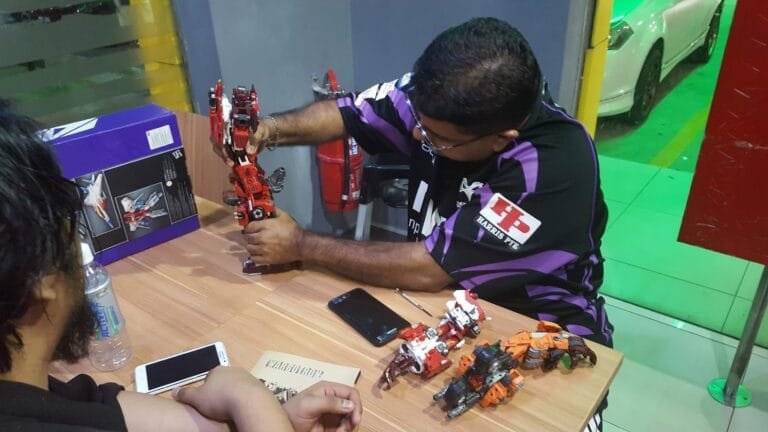
 The idea of an airplane changing shape mid-flight probably sounds farfetched to just about everyone, even fans of the Transformers movies and classic cartoons. However, new technologies that use metals called shape memory alloys (SMAs) are allowing researchers to develop components of aircrafts, cars, and even medical devices that can change and then regain their original shapes to perform different functions.
The idea of an airplane changing shape mid-flight probably sounds farfetched to just about everyone, even fans of the Transformers movies and classic cartoons. However, new technologies that use metals called shape memory alloys (SMAs) are allowing researchers to develop components of aircrafts, cars, and even medical devices that can change and then regain their original shapes to perform different functions.
Aaron Stebner, PhD fellow and SMA expert at Northwestern, will discuss these exciting technologies at a Junior Science Café event in Evanston on Friday January 21. Science in Society spoke with him for a preview.
What is a shape memory alloy (SMA)?
An alloy is a metal that is made up of two or more different elements. A pure nickel or a pure iron is just a single element (in theory – there are usually traces of other things) but to make an alloy, you’re combining substantial amounts of two or more different elements together to create properties that one of the single-element metals wouldn’t have on its own.
A shape memory alloy (SMA), then, is an alloy that has a shape memory behavior. It’s literally what it sounds like – it can “memorize” a shape. You can do all kinds of crazy things to it and then, under some kind of stimulus – usually by heating it up or removing some load from it – it will go back to its “memorized” shape. There are alloys that respond to other stimuli, such as magnetic fields, but the most abundantly used shape memory behaviors are triggered by changes in temperature or applied force.
What are SMAs used for?
Today, SMAs are predominantly used in the medical field. Nearly all stents are made out of SMAs. Orthodontic wires are also made out of SMAs. Their stimulus is a change in applied load. They’re stretched out (a large load is applied to them) before they’re tightened down against your teeth. That load is removed as your teeth come back to shape, and the alloys try to go back to their original shape, much like a rubber band would, only with a lot more force since they are metallic instead of rubber. Thus, they continue to align your teeth. My sister had non-SMA braces, and she had to get them tightened every week or two as the metals they were made from stayed stretched instead of springing back. Now, I think it’s usually more like every four to six weeks because of the shape-memory behavior.
Here at Northwestern, professors David Dunand and Cate Brinson are experts in developing and modeling porous, or non-solid, SMAs. One of the big potential applications for this is bone replacement. During hip or knee replacement surgery, these porous SMAs could be placed in your joint, and biological cells would grow within the pores of the alloy, adhering them to your existing biological systems. In addition to providing a place for cell growth, porosity provides a huge advantage relative to a solid material, because you can tailor how big the pores are, where they are, and how many there are, making the implant properties much more nearly match those of the bone that decayed or had been removed.
What is your area of expertise?
My personal research is being applied mainly in aerospace, though there is quite a bit of fundamental science I’m developing that is applicable to SMAs any field. I did my master’s research at the NASA Glenn Research Center and now collaborate a lot with Boeing and a company in California that makes SMA actuation wires called Dynalloy. We’re looking at literally morphing aircrafts, like creating Transformers, using SMAs. The poster [for my talk] shows a concept where the aircraft can actually flap its wings like a bird. That’s ultimately where we’d like to go. But in the near future, we’re starting by giving different parts of the aircraft the ability to change their shape for different flight segments.
You could imagine that if a vehicle is taking off, the optimal shape of its structures is a lot different than if it’s cruising at altitude – those demands are very different. The amount of air coming into the engine is very different, and the noise that it’s allowed to put out without causing too much acoustic pollution is different.
Right now, without the use of SMAs, aircraft structures are designed to one compromised configuration that can meet the demands of all the different flight segments and environments the vehicle might eventually go through. We’d like to either embed or make complete structures out of SMAs that could actively or passively change shape as the environment or flight requirements change. So you could have optimal fuel efficiency, reduce carbon dioxide emissions, and reduce acoustic pollution.
What can people expect from your Science Café event?
I really love showing people the magic of SMAs, and debunking some of the magic by teaching them how it happens. They’ll actually get to see an alloy that will change shape in the palm of their hand. They can hold it in the air and do all kinds of crazy things to it, but then the heat from their hand will make it take its memorized shape. We’ll look at how SMAs are being used in everyday devices, and dream up new ways they could be used in the future. It should be pretty fun.
-Triblocal






